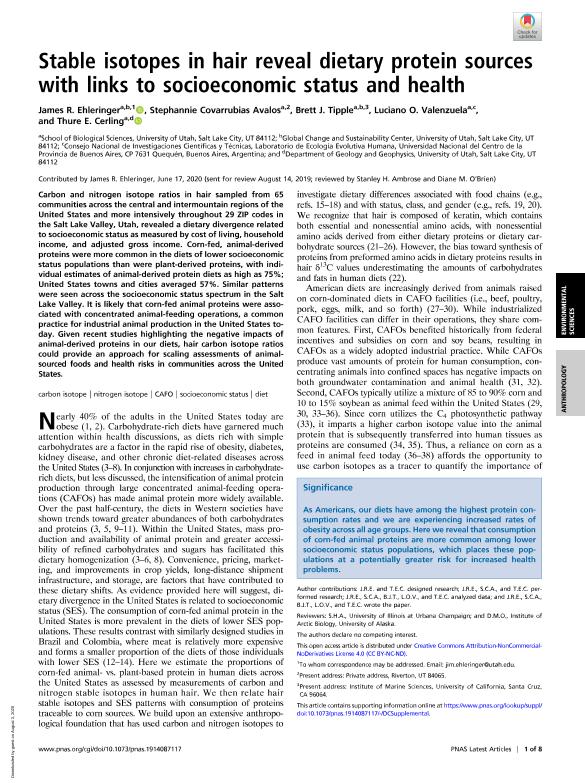Mostrar el registro sencillo del ítem
dc.contributor.author
Ehleringer, James R.

dc.contributor.author
Covarrubias Avalos, Stephannie
dc.contributor.author
Tipple, Brett J.
dc.contributor.author
Valenzuela, Luciano Oscar

dc.contributor.author
Cerling, Thure E.
dc.date.available
2020-11-03T01:23:51Z
dc.date.issued
2020-08
dc.identifier.citation
Ehleringer, James R.; Covarrubias Avalos, Stephannie; Tipple, Brett J.; Valenzuela, Luciano Oscar; Cerling, Thure E.; Stable isotopes in hair reveal dietary protein sources with links to socioeconomic status and health; National Academy of Sciences; Proceedings of the National Academy of Sciences of The United States of America; 117; 33; 8-2020; 1-8
dc.identifier.issn
0027-8424
dc.identifier.uri
http://hdl.handle.net/11336/117479
dc.description.abstract
Carbon and nitrogen isotope ratios in hair sampled from 65 communities across the central and intermountain regions of the United States and more intensively throughout 29 ZIP codes in the Salt Lake Valley, Utah, revealed a dietary divergence related to socioeconomic status as measured by cost of living, household income, and adjusted gross income. Corn-fed, animal-derived proteins were more common in the diets of lower socioeconomic status populations than were plant-derived proteins, with individual estimates of animal-derived protein diets as high as 75%; United States towns and cities averaged 57%. Similar patterns were seen across the socioeconomic status spectrum in the Salt Lake Valley. It is likely that corn-fed animal proteins were associated with concentrated animal-feeding operations, a common practice for industrial animal production in the United States today. Given recent studies highlighting the negative impacts of animal-derived proteins in our diets, hair carbon isotope ratios could provide an approach for scaling assessments of animal-sourced foods and health risks in communities across the United States.
dc.format
application/pdf
dc.language.iso
eng
dc.publisher
National Academy of Sciences

dc.rights
info:eu-repo/semantics/openAccess
dc.rights.uri
https://creativecommons.org/licenses/by-nc-sa/2.5/ar/
dc.subject
CARBON ISOTOPE
dc.subject
NITROGEN ISOTOPE
dc.subject
CAFO
dc.subject
SOCIOECONOMIC STATUS
dc.subject
DIET
dc.subject.classification
Otras Ciencias Médicas

dc.subject.classification
Otras Ciencias Médicas

dc.subject.classification
CIENCIAS MÉDICAS Y DE LA SALUD

dc.title
Stable isotopes in hair reveal dietary protein sources with links to socioeconomic status and health
dc.type
info:eu-repo/semantics/article
dc.type
info:ar-repo/semantics/artículo
dc.type
info:eu-repo/semantics/publishedVersion
dc.date.updated
2020-10-27T17:48:03Z
dc.journal.volume
117
dc.journal.number
33
dc.journal.pagination
1-8
dc.journal.pais
Estados Unidos

dc.journal.ciudad
Washington
dc.description.fil
Fil: Ehleringer, James R.. University Of Utah. Department Of Biology; Estados Unidos
dc.description.fil
Fil: Covarrubias Avalos, Stephannie. University Of Utah. Department Of Biology; Estados Unidos
dc.description.fil
Fil: Tipple, Brett J.. University Of Utah. Department Of Biology; Estados Unidos
dc.description.fil
Fil: Valenzuela, Luciano Oscar. Universidad Nacional del Centro de la Provincia de Buenos Aires. Facultad de Ciencias Sociales. Departamento de Arqueología. Laboratorio de Ecología Evolutiva Humana (Sede Quequén); Argentina. Consejo Nacional de Investigaciones Científicas y Técnicas. Centro Científico Tecnológico Conicet - Tandil; Argentina
dc.description.fil
Fil: Cerling, Thure E.. University Of Utah. Department Of Biology; Estados Unidos
dc.journal.title
Proceedings of the National Academy of Sciences of The United States of America

dc.relation.alternativeid
info:eu-repo/semantics/altIdentifier/url/https://www.pnas.org/content/117/33/20044
dc.relation.alternativeid
info:eu-repo/semantics/altIdentifier/doi/https://doi.org/10.1073/pnas.1914087117
Archivos asociados
